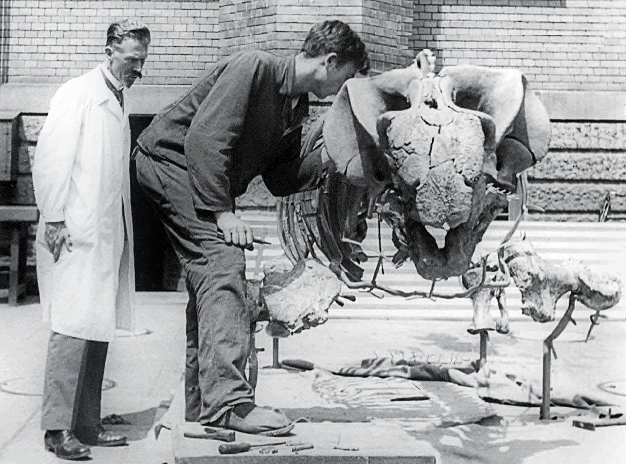Stahleckeria potens scale.svg on:
[Wikipedia]
[Google]
[Amazon]
''Stahleckeria'' is an extinct genus of Middle Triassic ( Ladinian) dicynodonts.''Stahleckeria''
at


 Skull of ''Stahleckeria'' measured in length. It was a contemporary of the more common '' Dinodontosaurus''. The differences between ''Stahleckeria'' and ''Dinodontosaurus'' may reflect adaptations to feeding on different plant species.
In 2012, fossils of ''Stahleckeria potens'' were described from the
Skull of ''Stahleckeria'' measured in length. It was a contemporary of the more common '' Dinodontosaurus''. The differences between ''Stahleckeria'' and ''Dinodontosaurus'' may reflect adaptations to feeding on different plant species.
In 2012, fossils of ''Stahleckeria potens'' were described from the
Brazilian Society of Paleontology
{{Portal bar, Paleontology Dicynodonts Anomodont genera Ladinian genera Middle Triassic synapsids of South America Triassic Brazil Fossils of Brazil Santa Maria Formation Middle Triassic synapsids of Africa Fossils of Namibia Omingonde Formation Fossil taxa described in 1935 Taxa named by Friedrich von Huene
at
Fossilworks
Fossilworks is a portal which provides query, download, and analysis tools to facilitate access to the Paleobiology Database
The Paleobiology Database is an online resource for information on the distribution and classification of fossil animals ...
.org It lived about 240 million years ago in what is now Brazil and Namibia. As a member of the group Kannemeyeriiformes, it was similar to the genus '' Kannemeyeria''. The genus is known from the type species ''Stahleckeria potens'', which was first collected from the Ladinian-age Santa Maria Formation in the Paleorrota fossil site of Brazil. ''Stahleckeria'' was named in honor of Rudolf Stahlecker
Rudolf Stahlecker (25 November 1898 in Sternenfels near Pforzheim – 26 October 1977 in Urach) was a German geologist and biology teacher.
Biography
He studied with the German paleontologist Friedrich von Huene at the University of TÃ ...
, who discovered the first specimens during a 1935 expedition led by paleontologist Friedrich von Huene
Friedrich von Huene, born Friedrich Richard von Hoinigen, (March 22, 1875 – April 4, 1969) was a German paleontologist who renamed more dinosaurs in the early 20th century than anyone else in Europe. He also made key contributions about v ...
to the Chiniquá fossil site.
Description
 Skull of ''Stahleckeria'' measured in length. It was a contemporary of the more common '' Dinodontosaurus''. The differences between ''Stahleckeria'' and ''Dinodontosaurus'' may reflect adaptations to feeding on different plant species.
In 2012, fossils of ''Stahleckeria potens'' were described from the
Skull of ''Stahleckeria'' measured in length. It was a contemporary of the more common '' Dinodontosaurus''. The differences between ''Stahleckeria'' and ''Dinodontosaurus'' may reflect adaptations to feeding on different plant species.
In 2012, fossils of ''Stahleckeria potens'' were described from the Omingonde Formation
The Omingonde Formation is an Early Triassic, Early to Middle Triassic (Anisian to Ladinian) geologic Formation (geology), formation, part of the Karoo Supergroup, in the western Otjozondjupa Region and northeastern Erongo Region of north-central N ...
in Namibia, which like the Santa Maria Formation is Ladinian in age. The Omingonde Formation is part of the Karoo Supergroup
The Karoo Supergroup is the most widespread stratigraphic unit in Africa south of the Kalahari Desert. The supergroup consists of a sequence of units, mostly of nonmarine origin, deposited between the Late Carboniferous and Early Jurassic, a perio ...
, which preserves many Triassic tetrapod fossils in southern Africa but notably lacks fossils in a hiatus called the "Ladinian gap". In addition to the remains of ''Stahleckeria potens'', fossils of the cynodont
The cynodonts () (clade Cynodontia) are a clade of eutheriodont therapsids that first appeared in the Late Permian (approximately 260 mya), and extensively diversified after the Permian–Triassic extinction event. Cynodonts had a wide variety ...
''Chiniquodon
''Chiniquodon'' is an extinct genus of carnivorous cynodonts, which lived during the Late Triassic (Carnian) in South America (Argentina and Brazil) and Africa (Namibia and Madagascar). ''Chiniquodon'' was closely related to the genus '' Aleodo ...
'' and an unidentified rauisuchian
"Rauisuchia" is a paraphyletic group of mostly large and carnivorous Triassic archosaurs. Rauisuchians are a category of archosaurs within a larger group called Pseudosuchia, which encompasses all archosaurs more closely related to crocodilians ...
have also been found in the Omingonde deposits. The presence of these animals in South America and in Africa at the same time is strong evidence that the two continents were once one uninterrupted landmass with a uniform climate and habitat that land animals such as ''Stahleckeria'' could travel freely between.
The fossils of ''Stahleckeria potens'' discovered in Brazil are currently in Germany in the museum of the University of Tübingen.
References
Bibliography
* Huene, F. von. 1936. "Die Fossilien Reptilien des südamerikanischen Gondwanalandes an der Zeitenwende (Denwa-Molteno-Unterkeuper = Ober-Karnisch)". ''Ergebnisse der Sauriergrabungen in Südbrasilien 1928/29''. Lieferung 2:93-159. * Huene, F. von. 1942.'' Die Fossilen Reptilien des Südamerikanischen gondwanalandes''. C.H. Beck Verlag, Munich.External links
Brazilian Society of Paleontology
{{Portal bar, Paleontology Dicynodonts Anomodont genera Ladinian genera Middle Triassic synapsids of South America Triassic Brazil Fossils of Brazil Santa Maria Formation Middle Triassic synapsids of Africa Fossils of Namibia Omingonde Formation Fossil taxa described in 1935 Taxa named by Friedrich von Huene